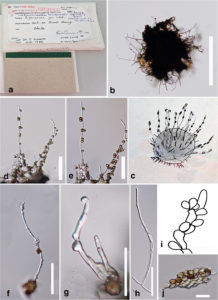Ascotrichella hawksworthii Valldos. & Guarro, Trans. Br. mycol. Soc. 90(4): 601 (1988)
Index Fungorum number: IF 133762, Facesoffungi number: FoF 02619
Saprobic on bird dung. Sexual morph: Ascomata 200–250 µm diameter, subglobose-ovoid, superficial, dark brown to black, with short, stiff hairs, dark brown, aseptate, long hairs hyaline to light brown, with emerging conidia, ostiole inconspicuous. Peridium walls composed of carbonaceous cell layers, thick-walled and dark brown. Paraphyses not seen. Asci not seen. Ascospores 6–8 × 3–5 µm, dark brown, unicellular, equilateral ellipsoidal, with a germ slit, running more or less the entire spore length (Valldosera and Guarro 1988). Asexual morph: hyphomycetous. Conidiogenous cells monoblastic, integrated, intercalary, hyaline to brown, cylindrical. Conidia 6–7 × 4–5 µm, solitary, simple, ovoid to ellipsoidal, dark brown, aseptate, developing on long ascomatal hairs, smooth when young, becoming veruculose (see Fig.).
Material examined – Chile, from dung, 21 June 1986, A.T Martinez and A.F. Gonzales (IMI 311114, isotype).
Notes – The holotype material is from Chile, but no deposition number is apparent. However, we have located the isotype material from IMI and illustrated it here. It should be noted here that this material contains only the asexual morph of A. hawksworthii, and only the remnants of the sexual morph are present.

Fig. 1 Ascotrichella hawksworthii. a Herbarium package details. b Ascomata. c Drawing of ascomata (redrawn from Valldosera and Guarro 1988). d, e Conidia developing on long ascomatal hairs. f–i Conidiophores. j Ascospores. Scale bars: b, c = 200 µm, d, e = 100 µm, f = 50 µm, j = 10 µm.
